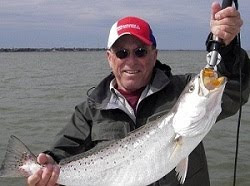Live shrimp is unbeatable trout bait in terms of all around effectiveness. The cost is relatively high and it can be difficult to keep alive in the summer heat of Galveston Bay, but many anglers will settle for nothing else. There are certain times during the summer months when natural baits will take more speckled trout than artificial baits.
Speckled trout are hard to please eaters who feed on fresh bait, not shrimp that has been frozen for a long period of time or that has a stink to it. Live shrimp works wonders around bay flats, reefs and along the edges of grass and marshes. These are areas where trout are likely to school in large numbers.
As far as some species of fish are concerned the larger the bait, the bigger the fish that is likely to be caught. In the case of speckled trout, however, the bait must be tailored to the waters being fished. Shrimp five to seven inches long make good bait for trout between four to six pounds, or when you are fishing the jetty waters or in passes or channels that hook up the bays to the Gulf of Mexico.
Larger shrimp are less effective in the bay areas. It has been my experience that shrimp about three to four inches are ideal to secure good stringers of trout. Whether you hook the shrimp under the horn or through the next-to-last section of the body, from the tail, depends on the size of shrimp and its stage of life.
Very small shrimp are difficult to hook under the spike. There are also times when the shell is very soft. In both cases, you need to hook the shrimp in the next-to-last part, next to the tail. I prefer to use the latter method at all times. The bait appears more natural and chances are you will not hook the area under the spike (commonly referred to as the brain). Many times, I feel it’s how you present the bait that will make the difference on whether the trout takes it at all. Sometimes try hooking the shrimp under the bottom (or the belly), giving the look of a crippled bait. Other times squeeze the head just enough to crack the shell. This also gives bait a disabled look and the juice will attract the trout due to the smell.
This time of year, be sure and get a early start to the bait camps along the Texas coast. Look for the flags, white in color. Eagle Point Camp in San Leon, always has this product, along with the famous crocker as well.
Speckled trout have extremely large mouths, and when they strike, they usually take the whole bait. But, this doesn’t mean they hold the bait for one or two counts before ingesting it. Many old saltwater anglers believe that trout take the bait headfirst. A lot of times, after a solid hit with live shrimp, the bait appears to be squeezed together (head to tail), giving the impression that trout grab the shrimp from the side rather than headfirst.
“Fresh” dead shrimp is excellent. Try heading and peeling it before putting it on the hook. Suspend the bait under a popping cork about three feet. Hook the entire shrimp through the body. “Jiggle” the rod tip and pop the cork carefully to give it a little action.
Another alternative to live shrimp, and my all-time favorite, is the use of artificial lures.
Successful fishing with these baits is an art that is not acquired by accident. It requires a technique that takes time, patience and practice. Until it’s mastered, this type of fishing can be quite unproductive. But, if the flags are not flying, do not hesitate to using soft plastics like Bass Assassins or Stanleys jigs.
But, regardless, have fun while fishing and enjoy the outdoors.
See Y’all on Galveston Bay.
Capt. Paul Marcaccio
Fishing Guide Galveston Bay: http://www.gofishgalveston.com
